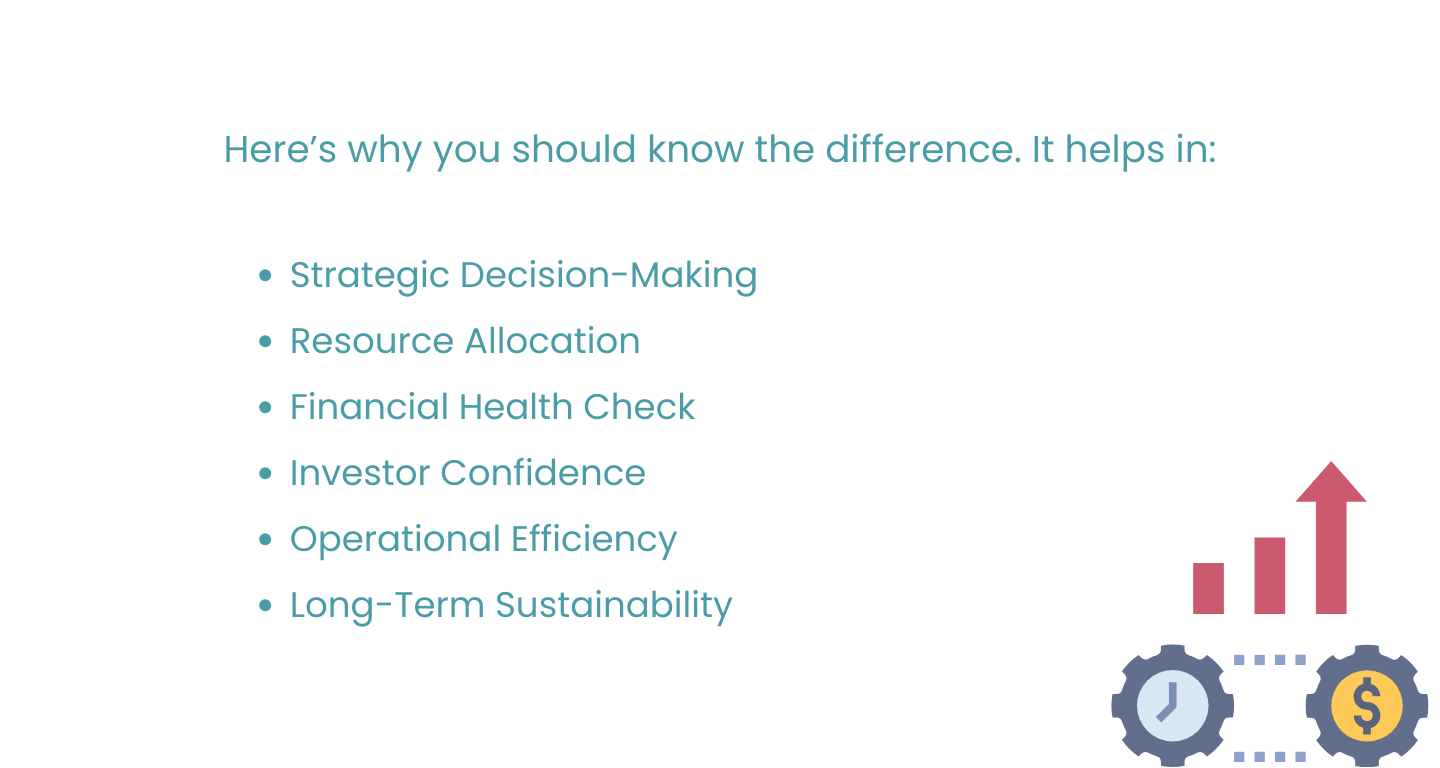Finance
Net Profit vs Gross Profit: What Sets Them Apart?
Article written by Kate Williams
Content Marketer at SurveySparrow
8 min read
9 May 2025

Think Net Profit and Gross Profit Are the Same? Think Again.
This blog breaks it down:
- Gross profit shows how efficiently you produce and sell.
- Net profit reveals the actual bottom line after every expense.
- A simple formula cheat sheet to calculate both using real-world examples.
Why confusing the two can wreck budgeting, forecasting, and growth strategies.
Bonus: How to use both metrics together for smarter financial planning.
Are you curious about Net Profit vs Gross Profit? Well, it’s not just about numbers. It’s about deciphering the financial code that propels your business forward.
Now, the burning question arises: Why do these financial metrics matter? But what exactly are they, and why do they matter?
What is Gross Profit (GP)?
Gross profit is the money your business makes after subtracting the direct costs of producing your product or service — things like materials, labor, and manufacturing expenses.
In simple terms:
Gross Profit = Revenue – Cost of Goods Sold (COGS)
It tells you how efficiently you’re turning your resources into income, before things like rent, salaries, or taxes come into play.
If your gross profit is shrinking, it’s a red flag — your production costs may be too high or your pricing strategy might need a rethink.
What is Net Profit (NP)?
Net profit is what’s left after you subtract all your expenses from your total revenue — not just production costs, but also rent, salaries, taxes, marketing, and any other overhead.
Think of it as your bottom line — the actual profit your business keeps.
Net Profit = Total Revenue – (COGS + Operating Expenses + Interest + Taxes)
It shows how financially healthy your business really is. You might have strong sales, but if your expenses are out of control, your net profit will tell that story.
If gross profit is about efficiency, net profit is about sustainability.
How to Calculate Net Sales and Gross Profit
So, let’s start by answering one crucial question- why does it matter to calculate net sales and gross profit?
Understanding these figures empowers you to make informed decisions, optimize pricing strategies, and navigate the financial journey.
Think of this as our practical guide to decoding the financial language of your business.
Calculating Net Sales:
To determine net sales, subtract returns and allowances from the total sales figure. It’s the net amount your business earns after factoring in any returns or deductions.
The formula is straightforward: Net Sales = Total Sales – (Returns + Allowances).
Calculating Gross Profit:
Moving on to gross profit, the key is subtracting the cost of goods sold (COGS) from the total revenue. This step isolates the income left after covering the direct costs of producing goods or services.
The formula for gross profit is GP= Total Revenue – COGS.
By mastering these formulas, you gain insight into the efficiency of your revenue generation and the direct costs associated with your core operations.
Now, we know the math behind the two metrics. But how do you go about it without hassle?
Have you considered how effortless this process can be with SurveySparrow? The user-friendly data collection tool streamlines the gathering of crucial financial metrics. It can’t get easier than this! Plus, imagine the clarity you gain with an advanced tool helping you out.
But you shouldn’t decide in a jiffy. Be careful about where you invest. After all, financial decisions should be made after serious consideration.
Give the free trial a spin and see for yourself first.

Explore Deeper Customer Insights with SurveySparrow
A personalized walkthrough by our experts. No strings attached!
Net Profit vs Gross Profit: A Comparison
| Gross Profit | Net Profit | |
|---|---|---|
| Definition | Revenue – COGS | Revenue – All Expenses |
| Focus | Operational Efficiency | Overall Financial Health |
| Scope | Limited Perspective | Comprehensive View |
| Calculation | Total Revenue – COGS | Gross Profit – Expenses |
| Key Insight | Production Efficiency | True Earnings |
| Strategic Use | Pricing Strategies | Informed Decision-Making |
| Financial Health | Initial Indicator | True Profitability |
Now, how about we go through this with the help of a simple example? For instance, a bakery.
1. Definition:
- Gross Profit (GP): We went through this once, but imagine your business is a bakery. Gross profit is the money left after covering the costs of flour, sugar, and other ingredients used to make the cakes.
- Net Profit (NP): Building on the bakery analogy, net profit remains after deducting all expenses, including staff wages, utility bills, and other operational costs, from the total revenue generated by selling those cakes.
2. Focus:
- GP: It zooms in on the efficiency of the bakery’s production line. Are ingredients being used effectively, and is the production process streamlined?
- NP: Takes a step back, examining the overall health of the bakery. It considers production and broader aspects like rent, salaries, and other operational expenses.
3. Scope:
- GP: Limited to the direct costs of making the product—the prices you can directly link to the bakery’s core function.
- NP: Expands the view to include all costs, giving a more comprehensive understanding of the bakery’s financial situation.
4. Calculation:
- GP: Calculate by subtracting the cost of ingredients (COGS) from the total revenue generated by selling the cakes.
- NP: Calculate by deducting all direct (like ingredient costs) and indirect (like rent and salaries) expenses from the initial revenue.
5. Key Insight:
- GP: Offers insights into the effectiveness of the bakery’s production process and pricing strategies.
- NP: Provides a clearer picture of the bakery’s true profitability by considering all operational and administrative costs.
6. Strategic Use:
- GP: Guides decisions on ingredient costs, pricing, and how efficiently the bakery produces cakes.
- NP: Informs broader strategic decisions, such as whether the bakery should expand or if there are areas where operational costs could be optimized.
7. Financial Health:
- GP: Act as an early indicator, showing how well the bakery covers its basic production costs.
- NP: Offers a more accurate assessment of the bakery’s overall financial health, considering all operational, administrative, and other associated costs.
The Importance of Knowing the Difference Between the Two
Understanding the nuances between gross and net profit is akin to having a reliable mentor guiding your business.

Strategic Decision-Making:
- Gross Profit Insight: Knowing your gross profit helps you fine-tune your pricing strategies and optimize production efficiency.
- Net Profit Insight: Understanding net profit goes beyond informing strategic decisions about overall business growth, expansion, or cost-cutting measures.
Resource Allocation:
- GP: Guides decisions on allocating resources directly related to production, such as sourcing materials efficiently.
- NP: Helps in broader resource allocation, considering operational costs, salaries, and other overheads.
Financial Health Check:
- GP: Acts as an initial check, indicating the efficiency of core operations in generating revenue.
- NP: Provides a more comprehensive financial health check, revealing the true profitability by considering all costs.
Investor Confidence:
- GP: Demonstrates your business’s ability to generate revenue efficiently.
- NP: Instills confidence in investors by showcasing a clear understanding of the complete financial picture. This ensures a more accurate assessment of potential returns.
Operational Efficiency:
- GP: Measures the efficiency of your production process and pricing strategies.
- NP: Reflects the overall efficiency of your business. And yes, it includes how well you manage operational and administrative expenses.
Long-Term Sustainability:
- GP: Focuses on short-term production efficiency and pricing.
- NP: Considers long-term sustainability, helping you make informed decisions for enduring success.
Metrics to Be Measured
While gross and net profit are crucial metrics, they’re not the sole navigators of your business’s financial journey. Consider these additional metrics as your co-pilots, offering unique insights into various aspects of your business. Moreover, they add layers to your financial understanding.
Gross Revenue vs Net Revenue:
Gross Revenue: The total revenue generated before any deductions.
Net Revenue: The revenue remaining after subtracting returns, allowances, and discounts. It provides a more accurate reflection of what your business earns.
Gross vs Net Revenue Recognition:
Gross Revenue Recognition: Recognizing revenue without deducting any costs.
Net Revenue Recognition: Recognizing revenue after deducting associated costs, providing a more realistic portrayal of income.
Wrap Up!
In the battle of “Net profit vs Gross Profit,” nobody wins. They are both crucial indicators of your growth.
Gross profit shows how well you’re producing and pricing. NP, on the contrary, gives the entire financial picture. It guides decisions in the long run. Think of gross profit as the starting point and net profit as the final destination.
Remember these points while making your next big financial decision!
Also, give SurveySparrow a try before you go. Take it for a spin; it’s free!

Explore Deeper Customer Insights with SurveySparrow
A personalized walkthrough by our experts. No strings attached!
Start 14 Days free trial

Kate Williams
Frequently Asked Questions (FAQs)
Gross profit only considers revenue minus the cost of goods sold (COGS), while net profit subtracts all operating expenses, taxes, interest, and other costs from total revenue. Net profit gives a complete view of your company’s profitability.
Because net profit includes a broader range of expenses—like salaries, rent, marketing, interest, and taxes—it is usually lower than gross profit.
Yes. This happens when the cost of operations and other expenses exceed the gross profit. It indicates that while sales are happening, the business may be overspending elsewhere.
Both are important. Gross profit shows how efficiently a company produces and sells goods, while net profit reflects the company’s overall financial health after all expenses.
Related Articles

Employee Experience
Revolutionize Employee Assessments: How Performance Evaluation Software Transforms Your Business
6 MINUTES
28 April 2023

Best Of
What is the Times Interest Earned (TIE) Ratio?
12 MINUTES
17 May 2021

Best Of
9 Samples of Feedback Forms for Customers That Work
10 MINUTES
18 June 2021

Best Of
5 Ways To Elevate Employee Experience
11 MINUTES
1 January 2021
